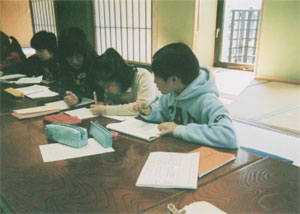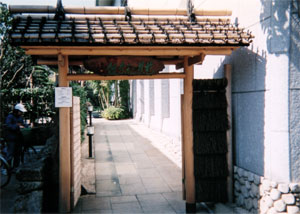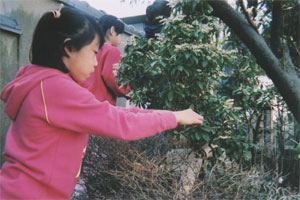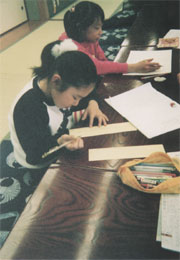|
It's a sunny March morning, and the kids are in a Japanese-style garden, looking for signs of spring. The willow bends to a gentle breeze that carries a faint scent of daphne, while carp lie still at the bottom of the pond. A girl opens her hand to reveal a piece of tosamizuki - tiny yellow flowers that grow into a conical cluster. "I've already got an idea for a verse," she says happily.
These kids have gathered for a class on haiku, a type of poem that has a 400-year-old tradition. Haiku is made up of just 17 syllables divided into three parts of 5, 7, and 5 syllables each. That may seem awfully short, but deep emotions and profound thoughts can be compressed into this format by carefully choosing the right words. "It's really fun making your feelings fit exactly into the haiku form," says fifth-grader Kumi Shimada.
Although it was once thought to be something only adults could compose, haiku is now catching on among kids. Soft drink maker Ito-en holds a haiku contest every year, and the number of verses entered by elementary school kids has grown to 293,292 this year, up from 162,564 in 1998. Schools are encouraging the study of haiku in Japanese literature classes as well; last year, 786 elementary schools entered their pupils' works in the Ito-en contest.
A popular TV program with a corner for children's haiku probably had a part in popularizing the verse form among kids, says Terutoshi Sugiyama, curator of the Basho Memorial Museum in Tokyo. The museum is dedicated to the great seventeenth-century haiku master Matsuo Basho. Each month, the museum holds haiku classes for children.
As a rule, a haiku must contain a word or phrase connoting a season. This can be the name of a plant like tosamizuki, a natural phenomenon like the spring rain, or a seasonal event like the Hina Matsuri (Girls' Festival) in March. This month's theme was "spring," so the first thing the kids did was to run outside in search of a seasonal phrase. Some wandered among the trees and looked into the pond for sleepy toads. Three girls sat side by side with a notebook and pen, contemplating the museum's garden. "When you're with friends, you sometimes come up with ideas you wouldn't have on your own," says one of them, Yu Kaneko.
The kids then came back inside to write down their haiku on a strip of
paper. They followed a procedure that's commonly used in haiku contests for adults: The verses are collected and rewritten on large sheets of paper so you can't tell who wrote which one. They're passed around, and everyone selects his or her favorite verses - excluding your own. Each selection is read out loud by the teacher, and whenever your haiku is read, you identify yourself by calling out your name - a proud and exciting moment. The verse that gets read most often is named the best haiku of the day.
Third place went to fifth-grader Rie Ogoshi for her verse, "Tosamizuki / Dainty but luminous / Like tiny light bulbs." Ai Suzuki, a third-grader, took second prize with "Still cold, and yet / A delicate softness / Water in springtime."
The haiku master of the day, though, was Yasuaki Takagi, a fourth-grader, who received six votes for, "Where's my body pillow? / Alas, in my sister's grasp! / Nighttime in spring." This was a unique way describing the fact that nights are still quite chilly in early spring. "It usually takes me about an hour to come up with a haiku," Yasuaki says. "This one came to me right away because it's something that happened only this morning!"
Photos: (Top) Choosing your favorite haiku; (Second) The entrance to the Basho Memorial Museum; (Third) Looking for signs of spring in the Japanese-style garden; (Bottom) A haiku is born.
|




